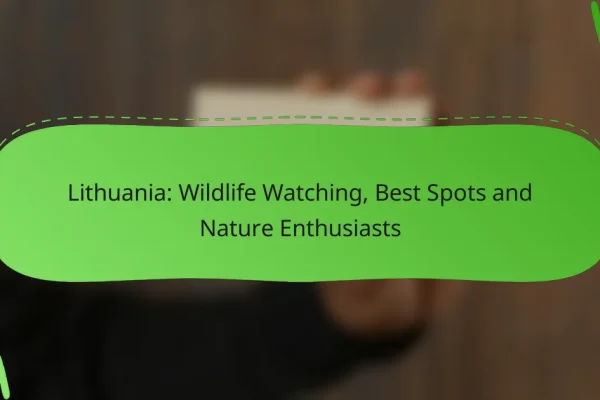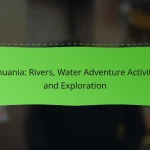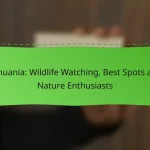What are the must-see natural wonders in Lithuania?
Lithuania boasts a variety of stunning natural wonders that showcase its diverse landscapes. Key highlights include unique coastal formations, expansive national parks, and serene lakes, each offering distinct experiences for visitors.
Curonian Spit
The Curonian Spit is a UNESCO World Heritage site known for its stunning sand dunes and unique ecosystems. Stretching between the Curonian Lagoon and the Baltic Sea, this narrow strip of land offers beautiful beaches, lush forests, and a rich variety of wildlife.
Visitors can explore hiking trails, enjoy birdwatching, or relax on the sandy shores. The area is also home to charming fishing villages, where you can experience local culture and cuisine.
Giant’s Hill
Giant’s Hill, or “Piliakalnis,” is a prominent hill located near the town of Trakai, offering panoramic views of the surrounding landscape. This site is steeped in legend, with tales of giants who once roamed the area.
The hill is an excellent spot for hiking and photography, especially during sunrise or sunset. It is advisable to wear sturdy shoes as the trails can be steep and uneven.
Žemaitija National Park
Žemaitija National Park is a vast area featuring forests, lakes, and rivers, making it a haven for outdoor enthusiasts. The park is known for its diverse flora and fauna, including rare species of plants and animals.
Visitors can engage in activities like hiking, cycling, and fishing. The park also offers educational trails and visitor centers that provide insights into the region’s natural history and cultural heritage.
Lake Plateliai
Lake Plateliai is the largest lake in Žemaitija National Park and is famous for its clear waters and picturesque surroundings. It is an ideal location for swimming, kayaking, and picnicking.
The lake is surrounded by scenic walking paths and offers various recreational facilities. Keep an eye out for local wildlife, including swans and various fish species, which thrive in this clean environment.
Devil’s Mountain
Devil’s Mountain, or “Velniakalnis,” is a unique geological formation located near the town of Anykščiai. This site is characterized by its steep slopes and intriguing rock formations, making it a popular destination for hikers and nature lovers.
Legends surrounding the mountain add to its allure, with stories of mythical creatures and ancient rituals. Visitors should prepare for a moderate hike and can enjoy the surrounding forest trails that lead to breathtaking viewpoints.
How can I explore Lithuania’s natural landscapes?
You can explore Lithuania’s natural landscapes through guided tours, self-guided hiking trails, and various camping options. Each method offers unique experiences and access to the country’s stunning scenery, including forests, lakes, and national parks.
Guided tours
Guided tours in Lithuania provide an excellent way to discover the country’s natural beauty with the help of knowledgeable locals. These tours often include transportation, making it easier to reach remote areas like the Curonian Spit or Aukštaitija National Park.
Many tour operators offer options ranging from day trips to multi-day excursions, with activities such as birdwatching, kayaking, and nature photography. Prices typically range from €50 to €150 per person, depending on the length and inclusions of the tour.
Self-guided hiking trails
Self-guided hiking trails are abundant in Lithuania, allowing you to explore at your own pace. Popular trails include the 100-kilometer-long Žemaitija National Park route and the scenic paths around Lake Galvė.
When planning a hike, consider downloading maps or using mobile apps that provide trail information. Most trails are well-marked, but it’s advisable to carry sufficient water and snacks, as amenities may be limited in remote areas.
Camping options
Camping in Lithuania is a fantastic way to immerse yourself in nature. There are numerous campsites available, particularly near national parks and lakes, with facilities ranging from basic to more developed sites with amenities like showers and electricity.
Wild camping is also permitted in many areas, but it’s essential to follow local regulations and practice Leave No Trace principles. Campsite fees can vary, typically ranging from €10 to €30 per night, depending on the location and facilities offered.
What are the best times to visit Lithuania’s natural sites?
The best times to visit Lithuania’s natural sites are spring, summer, and autumn, each offering unique experiences. Spring showcases blooming flora, summer is ideal for outdoor activities, and autumn presents stunning foliage.
Spring for blooming flora
Spring in Lithuania, typically from March to May, is a vibrant time when flowers and trees come to life. The countryside is dotted with colorful blossoms, making it perfect for nature walks and photography.
Consider visiting parks like the Botanical Garden in Vilnius or the Curonian Spit, where you can enjoy the sight of tulips and other spring flowers. The temperatures range from cool to mild, so dress in layers for comfort.
Summer for outdoor activities
Summer, from June to August, is the prime season for outdoor adventures in Lithuania. With long daylight hours and warm temperatures, it’s an excellent time for hiking, cycling, and water sports.
Popular destinations include the lakes of Trakai and the beaches of Palanga. Be prepared for occasional rain, and pack sunscreen and insect repellent to enhance your experience.
Autumn for foliage
Autumn, spanning September to November, transforms Lithuania’s landscapes into a tapestry of reds, oranges, and yellows. This season is ideal for enjoying scenic drives and hikes through national parks.
Visit places like Aukštaitija National Park or the forests around Anykščiai for breathtaking views. The weather can be unpredictable, so it’s wise to check forecasts and dress accordingly for cooler temperatures.
What activities can I enjoy in Lithuania’s natural wonders?
In Lithuania’s natural wonders, visitors can engage in various outdoor activities that highlight the country’s stunning landscapes. Popular options include birdwatching, hiking, and kayaking, each offering unique experiences in different natural settings.
Birdwatching in the Curonian Lagoon
The Curonian Lagoon is a prime spot for birdwatching, attracting numerous migratory species throughout the year. Birdwatchers can expect to see a variety of waterfowl, including swans, geese, and herons, especially during spring and autumn migrations.
To enhance your birdwatching experience, consider visiting the ornithological observatory located near the lagoon. Bring binoculars and a field guide to help identify species, and be mindful of local regulations to protect wildlife habitats.
Hiking in Aukštaitija National Park
Aukštaitija National Park offers a network of well-marked hiking trails that showcase Lithuania’s diverse ecosystems, including forests, lakes, and wetlands. Trails vary in difficulty, catering to both casual walkers and experienced hikers.
When planning a hike, check trail conditions and weather forecasts. Popular routes include the 12-kilometer loop around Lake Pusaviečiai, which features scenic views and opportunities for wildlife spotting. Always carry sufficient water and snacks, and consider using trekking poles for added support.
Kayaking on the Neman River
Kayaking on the Neman River provides an adventurous way to explore Lithuania’s waterways. The river flows through picturesque landscapes, making it ideal for both leisurely paddling and more challenging excursions.
Rentals are available from local outfitters, and guided tours can enhance your experience by providing insights into the area’s ecology and history. Be aware of the river’s flow conditions and plan your trip according to your skill level, with options ranging from short day trips to multi-day adventures. Always wear a life jacket and follow safety guidelines while on the water.
What are the conservation efforts for Lithuania’s natural wonders?
Lithuania is actively engaged in conservation efforts to protect its natural wonders through various initiatives, including the establishment of protected areas and national parks. These efforts aim to preserve biodiversity, maintain ecosystems, and promote sustainable tourism while ensuring that natural resources are used responsibly.
Protected areas and national parks
Lithuania boasts several protected areas and national parks, which play a crucial role in conserving its unique landscapes and wildlife. Notable examples include the Curonian Spit National Park, a UNESCO World Heritage site, and Aukštaitija National Park, known for its lakes and forests.
These parks are governed by specific regulations that limit activities such as logging, hunting, and fishing to protect the environment. Visitors are encouraged to engage in eco-friendly tourism practices, such as hiking and birdwatching, to enjoy the natural beauty while minimizing their impact.
To support conservation, local authorities often organize educational programs and volunteer opportunities. Engaging with these initiatives can enhance awareness of Lithuania’s natural heritage and contribute to its preservation.






